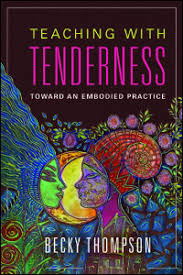Teaching with Tenderness

I would never have heard of this book unless Laura Webber recommended it to me. She is working with us at the Alliance for Peacebuilding this summer on our recently renamed neuroscience project, Peace Rewire. Laura is both a peacebuilding graduate student and an experienced yoga instructor who is trying to combine the two in her academic work. I figured I had a lot to learn from her. I was writing. My education started with this book.
Thompson, too, combines yoga and academics in her work as a sociologist who is interested in gender and race and most of the other issues that eddy around those fields. Even though those are issues I’m interested in, I didn’t expect that this book would lead me to rethink everything I’ve done in the classroom for almost half a century. That’s just what Becky Thompson did with Teaching with Tenderness. What she means by that is clear on the second page of the book (at least in my Kindle edition:
By tenderness I mean an embodied way of being that allows us to listen deply to each other, to consider perspectives that we might have thought way outside our own worldviews, to practice a patience and attentiveness that allow people to do their best work, to go beyond the given, the expected, the status quo. Tenderness makes room for emotion; offers a witness for experiences people have buried or left unspoken; welcomes silence breath, and movement; and sees justice as key to our survival.
I had already been (re)thinking what happens in classrooms now that I’ve been sitting in on and vaguely helping my friend Doug Irvin-Erickson’s classes for the last year and a half and spending more time at George Mason’s School of Conflict Analysis and Resolution. Put simply, I’d already been reconsidering what happens in classrooms before I read this book.
 Teaching with Tenderness so swept me off my feet that I could not summarize her findings without a) doing injustice to her ideas or b) writing at least a ten page review.
Teaching with Tenderness so swept me off my feet that I could not summarize her findings without a) doing injustice to her ideas or b) writing at least a ten page review.
So, let me focus on my reactions because they apply not just to classrooms but to any place where we work for social and political change or deal with hierarchies. In other words, they apply just about everywhere we work because they invoke the.
- Emotions of the subject. They have to be addressed in just about everything I taught. That certainly applies to peace and conflict studies, but also to comparative politics, which I focused on for the bulk of my career. Emotional issues are raised the minute you talk about controversial issues which is why I was drawn to these fields in the first place after realizing I didn’t have the talent or the stamina for physics! That said, I did not raise those controversial and emotional issues as squarely as I would have now that I read her book.
- Emotions of the student (or employee). I sort of knew this mattered early on since one of my first students had been my camper when I was a counselor and he was nine or ten. Another had grown up around the corner from me and was only six years younger than I was. I also realized that some of my struggles struggled because they had unresolved personal issues that had little or nothing to do with the classroom. I always had a vague sense that I had to teach the “whole student,” but I did not do so as intentionally as Thompson clearly does. The same holds for how I deal with the young people who work with us at AfP.
- Emotions of the teacher (or supervisor). I fell farther from the mark here. I have always known that I bring my own emotional issues to the classroom. That can be positive, since the passion I have for my subject matter invariably comes through in the classroom—and even in my writing. However, I could and should have addressed the areas in which my lack of self-awareness got in the way. That rarely had much to do with my uncertainties about the subject matter, of which there have been plenty over the years, as well there should be in fields like mine. However, it’s now clear that my own raw emotional edges kept me from being as fully “present” as I would like to have been in the classroom or at the workplace.
In the end, I’m probably not going to go as far as Thompson does. I’m unlikely to bring yoga or poetry into a class or into the AfP office. I’ll probably always focus more on content delivery in my public talks than she does in the classroom.
Still, as someone who reads a lot, this is the first book I’ve read in ages that made me go back to the basics of who I am and how I organize my professional life.
Read it.
